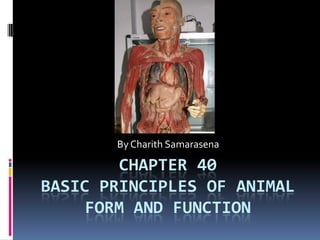
Chapter 40.ppt
- 1. Chapter 40Basic principles of animal form and function By Charith Samarasena
- 2. Vocabulary Acclimatization: physiological adjustment to a change in an environmental factor Stressed-induced proteins: proteins that are activated by the factors of stress Heat shock proteins: proteins that help protect other proteins under heat stress Torpor: a physiological state in which activity is low and metabolism decreases Hibernation: a physiological state in which metabolism decreases, the heart and respiratory system slow down, and body temperature is maintained at a lower level than normal Estivation: a physiological state that allows animals to survive in warmer temperatures and very low water supply
- 3. Hierarchical Organization of Body Plans (Ascending) Tissues: groups of cells of similar appearance and common function Organs: functional units of tissue Organ System: groups of organs that work together providing an additional level of organization and coordination
- 4. Tissue There are 4 types of tissues: -Epithelial -Connective -Muscle -Nervous
- 5. Epithelial Tissue Covers outside of the body and lines the organs and cavities within body Epithelium have four shapes: -cuboidal (like dice) -columnar (bricks standing on end) -squamous (like floor tiles)
- 6. Epithelial Tissue cont’d Epithelium cells can be arranged as: -simple epithelium (single cell layer) -stratified epithelium (multiple tiers of cells) -pseudostratified epithelium (single cell layer varying in height)
- 7. Connective Tissue Bind and support other tissues in the body Connective tissue cells are scattered throughout extracellular matrix Types of connective tissue: -cartilage -adipose tissue -fibrous connective tissue (tendons and ligaments) -loose connective tissue
- 9. Muscle Tissue Responsible for nearly all types of body movement Consist of filaments containing actin & myosin Types of muscle tissue: -skeletal muscle -cardiac muscle -smooth muscle
- 10. Nervous Tissue Sense stimuli and transmit signals in the form of nerve impulses from one part of the body to another Contains neurons and glial cells
- 11. Cell Signaling Can be done via the nervous system Can also be done via the endocrine system in the form of hormones
- 12. 4 Ways To Gain, or Lose, Heat From or To Environment Radiation Evaporation Convection Conduction
- 13. Radiation The emission of electromagnetic waves by all objects warmer than absolute zero Transfers heat between objects indirectly
- 14. Evaporation Removal of heat from the surface of a liquid that is losing some of its molecules as gas
- 15. Convection Transfer of heat by movement of air or liquid past a surface
- 16. Conduction The direct transfer of heat between molecules of objects by direct contact
- 17. Endotherm Aka regulator; maintains a separate body temperature from that of external environment; uses principle of homeostasis Homeostasis is not maintained the animal dies
- 18. Ectotherm Aka conformers; change body temperature to match external environment Heat is gained from external sources If there is not enough heat for the animal to absorb it dies
- 19. 5 Methods of Thermoregulation Insulation Circulatory Adaptations Cooling by Evaporative Heat Loss Behavioral Responses Adjusting Metabolic Heat Production
- 20. Insulation Reduces heat flow between animal and its environment Sources of insulation include hair, feathers, and layers of fat formed by adipose tissue (all are important for mammals and birds)
- 21. Circulatory Adaptations Vasodilation: relaxing of muscles of vessel walls to increase blood flow; increases body temperature Vasoconstriction: contraction of muscles of vessel walls to decrease blood flow; decreases body temperature
- 22. Circulatory Adaptations cont’d Countercurrent exchange: the flow of adjacent fluids in opposing directions that maximizes transfer of rates of heat or solutes (especially important in birds and mammals) Heat transfer involves antiparallel arrangement of blood vessels
- 23. Cooling by Evaporative Heat Loss When body begins to overheat, animals begin to lose water which absorbs a lot of heat Then, the water evaporates across the skin and into the atmosphere releasing heat (ex. sweating)
- 24. Behavioral Responses Some animals, such as amphibians and reptiles, will simply move to different locations when they feel to hot or cold Other animals, like invertebrates, move bodies to control heat gain Some animals may huddle to conserve heat
- 25. Adjusting Metabolic Heat Production Shivering and nonshivering thermogenesis(in cold weather) can increase metabolic heat production Switching types of thermoregulation can help in heat gain, like switching from ectothermy to endothermy (large reptiles like snakes may do this to keep eggs warm)
- 26. Hypothalamus A component of the brain that contains nerve cells that detect change in temperature throughout body Crucial to homeostasis because hypothalamus tells blood vessels to constrict or dilate to increase or decrease body temperature
- 27. Thermoregulation by Hypothalamus (“-” feedback)